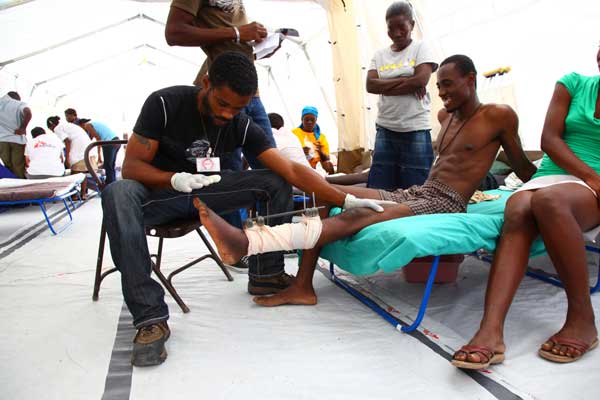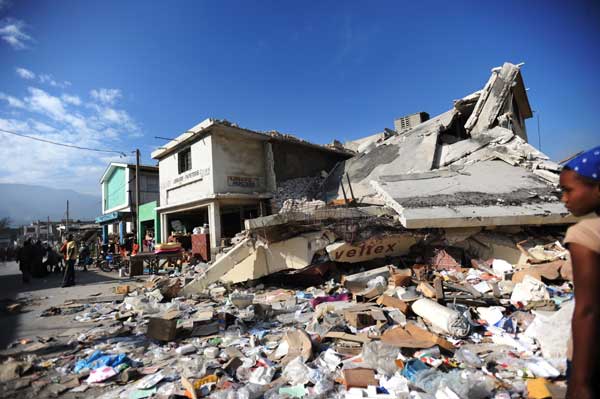I arrived in Haiti within two weeks of the earthquake. The devastation was out of this world. You had to really stare at the rubble to work out what you were seeing. You’d see sandwiches of concrete slabs squashed down like a concertina, and realise that it was once a multi-storey building. There were still bodies trapped so you could occasionally smell death.
There were makeshift shelters everywhere. It seemed like every square inch of public space was taken by people. What struck me was that it was a very, very vulnerable population, all living outside.
There were a lot of aftershocks. Sometimes I didn’t notice the smaller tremors but what I would notice was the panic in everyone around me.
The Haitians were incredible, they were so keen to work for us, even though many had lost family members and had nothing left. The Haitians we employed were so full of energy and motivation it gave the project such a beautiful boost.
At first we were focusing on the life-threatening injuries, providing emergency surgery and post-operative care. I was on my third field placement as a nurse, but it quickly became apparent my role would involve more than nursing.
The Medical Coordinator said that what I needed to do was open a hospital with 100 beds, plus surgical capacity, in about two days. We had negotiated a space at the back of a school but we had nothing else. No water, no electricity, just a cleared area surrounded by rubble.
I didn’t even have time to worry about it; I had to hit the ground running. What was incredible was that MSF was just starting to mobilise a huge logistical effort. We had cargo planes landing, full of tonnes of stock, so anything I needed I just asked for and people worked on it. Within two days we did actually open the hospital and receive our first patients off the back of army trucks.
What I remember strongly from this mission was the strength of the logistics response. It’s that capacity that makes the organisation strong, effective and efficient. Medical work is important, but you can’t do anything without the logistics. The buzz of this project, with so many people working together, was amazing.
Once the hospital was open, there were rows and rows of people with their broken limbs in traction. The amputees were all in a row nearby.

It’s very confronting when you see this scale of injuries, but I’ll never forget the Haitians’ fantastic sense of humour. They were all joking with each other about who had lost more limbs because they were all in the same boat.
I’ve never forgotten that ability to find humour in the middle of such devastation. It was amazing – but of course, there were a lot of mental health needs too.
There are so many patients whose stories have stuck with me over the years. One boy had been having an appendectomy on the day of the earthquake. He was left in a post-operative surgical ward, completely neglected.
He eventually made it to our hospital in an appalling state, very malnourished and fighting a massive infection. So it wasn’t only direct injuries that we treated – the earthquake affected people in so many ways.
There was another little girl who was three or four years old and had lost all of her family in the quake. They were just killed around her. She came in with broken hips and pelvis, so she was in traction, like most of the kids, unable to move for weeks.
She was particularly traumatised and wouldn’t interact with anybody. She just cried when anyone went near her. The process of medical care was terrifying, and she was just a little kid on her own, who wanted her mum.
Our psychologists did some beautiful work to bring her out of her shell, and the days when she started smiling and interacting were the happiest days for most of our staff.
At the time, the Red Cross were trying to reunite children with any extended family. One day, after many long weeks, they showed this little girl photos of someone they thought might be her aunty, and she started jumping, crying, and clearly showing that she knew this woman.
I will never forget the day when this lady came into the clinic, just the way they hugged, it was like peace descended on this girl. Her whole body relaxed. Everybody was crying. It was a moment of joy in a tragic situation.
Editor’s note: The earthquake on January 12, 2010, apart from killing more than 200,000 people and displacing more than 1.5 million, the 7.0 magnitude earthquake destroyed over 300,00 buildings.
The United Nations Development Program reports: “Since then, Haiti has successfully pulled through the humanitarian recovery phase and seen significant socio-economic gains. The country has steadily boosted the net enrollment rate in primary education and achieved equal participation of boys and girls. The number of underweight children under five years old has been halved, the prevalence of HIV/AIDS has stabilized, and nearly 70 percent of households now have access to an improved source of water.

“Yet as Haiti moves toward long-term, sustainable development, the country faces significant challenges. 60 percent of Haitians live on less than $2.50 a day. The political system remains fragile, sustainable jobs are scarce, and the environment is still as vulnerable now as it was then.
“UNDP is focusing on long-term support, to help build a structurally sound, resilient and sustainable Haiti. Governance, disaster risk reduction, and environmental protection are at the heart of our work, in concert with the Haitian people, elected officials, the private sector and the international community.
“Through 39 projects, 335 people and an annual budget of over USD $35 million, UNDP is creating thousands of jobs and increasing its reconstruction efforts and support to community planning.”
On the health front, when the earthquake hit Haiti, 60 per cent of an already dysfunctional health system in Haiti was destroyed in an instant. In addition to this, 10 per cent of Haiti’s medical staff were either killed or subsequently left the country. The impact was catastrophic. Médecins Sans Frontières had already been present in Haiti for the previous 19 years, filling pre-existing healthcare gaps. Most health systems would struggle with a cataclysmic event such as this, let alone one that was already struggling under normal circumstances.
Five years on, the vast majority of the Haitian people still struggle to access the healthcare they need. The HUEH (Hôpital de l’Université d’Etat d’Haiti), the only public hospital offering orthopaedic surgical care in the country, has still not been fully rehabilitated and so cannot run at full capacity. While money has been spent on building hospitals, quite a few, such as one built in Carrefour, currently stand as empty shells because of inadequate planning to ensure proper trained staff, sufficient drugs, money, guaranteed maintenance and medical material to run them.
You can find out more about efforts to rebuild Haiti by visiting the United Nations Development Programme here.
And you can find out more about the outstanding work of Doctors Wihout Borders Australia here.
Donate To New Matilda
New Matilda is a small, independent media outlet. We survive through reader contributions, and never losing a lawsuit. If you got something from this article, giving something back helps us to continue speaking truth to power. Every little bit counts.



